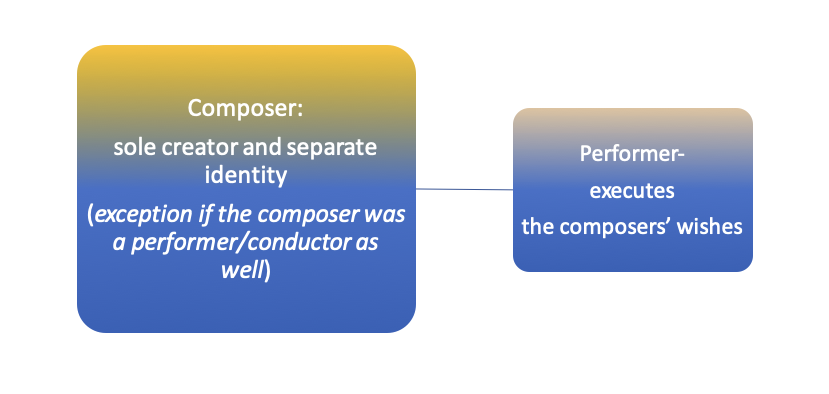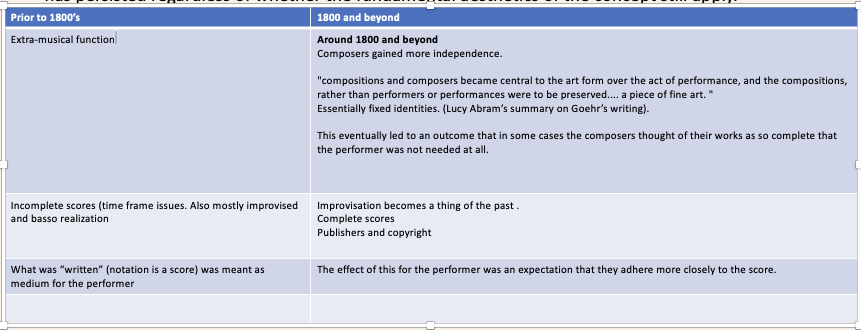CHAPTER 2
What are my roles as a Violist when collaborating with living composers?
For the purposes of my research I am defining the word collaboration to simply mean “to work with”.
As discussed in the introduction, there is a need for me to understand what my roles are as a violist when collaborating with living composers. I have therefore studied literature and spoken with performers and composers to clarify the discourse around these roles and discover how I can improve my own personal collaborative processes with composers.
In the previous chapter, I examined the roles and responsibilities taken on by Tertis, I also chose to focus on current violist and composer Dean. From both of these role models, I have drawn the following common threads:
The roles of the violist in collaborations with composers are:
As Violists, performers, promoters, communicators and contributors to the expansion of the viola repertoire.
In this chapter I will discuss the process of collaboration between composers and performers and in both historical and contemporary contexts. I will freely interchange the broader term ‘performer’ with violist at times, as I have been able to draw parallels between case studies of performers with composers, who are not necessarily violists.
2.1 A Historical context
Up until the late 19th Century the viola was given a supportive role as a middle voice in the orchestra. The viola was the poor cousin of the violin and treated as one by other members of the orchestra and composers alike. The violist played in the ‘Engine room’ of the orchestra, the middle voice in the harmony.
There are some exceptions like in the works of Mozart and Berlioz which are well known for their treatment of the viola.
Familiar now with Tertis’s pivotal roles in promoting the instrument it is no surprise that he writes:
“There were two red-letter days for the viola, both of immense significance to its cause as a solo instrument: one in 1779, when Mozart created the Sinfonia Concertante or violin, viola and orchestra, and the other in 1834 when Berlioz composed Harold in Italy for orchestra and solo viola. Both these great men were conscious of the characteristic and attractive tone quality of the instrument.”46
As the status of viola has risen, with the instrument emerging into a solo role, the opportunities for violists to explore collaborations with composers have also grown.
2.2 The Kanga example
Pianist Zuben Kanga’s “Inside composer performer” published on the 14th May, 2014 in the Australian Music Centre’s magazine- ‘Resonate’ is based on performer/composer collaborations. Here Kanga describes his research into “the process of collaboration between composer and performer.”47
He argues that his collaborations have disproven the myth of “composer of sole creator- the lone genius who hands sacred texts to the performer who merely executes his wishes.“48
Kanga then describes his own view of the collaborative experience where “the creative input of performers is as important as composers to the creative process (…) boundaries between these two roles often dissolve and are reformed: in some cases, power play and conflicts over creative territory dominate the process, while in others an intimacy develops which allows the roles to remain ambiguous.”49
Kanga refers to recent research which has “challenged these myths, showing the complexity of Johannes Brahms’s collaboration with Joseph Joachim, François Poulenc’s with Pierre Bernac, Benjamin Britain's with Peter Pears and John Cage’s with David Tudor.“50
He observes that recent ethnographic research on the context of composer – performer collaborations shows a blurring of roles in the context of the creation of new music.51
At the Royal Academy in London, he documented 48 collaborations. In 42 of these collaborations he was involved as the performer. 30 of them featured the creation of a new work. These collaborations were conducted through various workshops over differing periods of time.52
He selected both senior (often established composers) and emerging composers for his practical research. The reason behind this was to evaluate if there was a disparity in the process of these different collaborations. He found that generally the composer’s personality played a more significant role than their seniority in the collaborative relationship.53
His practical research demonstrated that none of these collaborations could be described in terms of the conventional model of musical creativity, with the composer as a sole author of musical works. In relation to conventional performance practice, he concludes that there is a problem that occurs in new and recent works, namely that contemporary approaches to instrumental techniques, notation, interaction and other media and to musical expression require new knowledge to be created and shared in workshops. Many of the details in these situations cannot be notated and therefore only the original creators can be privy to them and as a result much of the finer detail of these collaborations has been irrecoverably lost.54
Kanga also suggests tools that can benefit future performer-composer collaborations. He suggests that “mutual knowledge of musical repertoire” 55 shared between collaborators aids explanations. He suggests communicating The tool of priorities early to make more efficient use of workshop time. He argues that communicating through playing is important as this cannot be captured in written or spoken language. He also suggests that having a good sense of humour can help in resolving or avoiding disputes.56 These tools are useful for the next chapter where I will be discussing my responsibilities when collaborating with living composers.
It is important to delve more deeply into ‘the myth’ perpetuated by the conventional model of musical performance. This is historical, hierarchical tradition in Western Art Music that establishes a strong separation of composers and performers with their own identities and tasks.
2.3 The Myth?
This traditional hierarchy in Western Art Music (which I will refer to as WAM) illustrates the divide between composer and performer. Add to this the fact that composers did not generally write for the viola as a solo instrument and the historical divide becomes greater still. Lionel Tertis, referred to himself continually as “an interpreter of music.”57
According to Cook in his book, ‘Music As Creative Practice, this ideology separating composers and performers into creators and executors became commonplace throughout most of the 20th century. In the 21st Century the legacy of this view lives on in concert live. However today’s WAM is evolving to incorporate more nuanced collaborations between composers, performers and (multi-media) artists of all kinds.58
Currently WAM’s traditional performance practices are passed on through pedagogues and conservatoires. In addition, there is a great deal of knowledge incorporated into performance practice derived from historical treatises and texts meant to help understand the background, environment, influences and aesthetics of period in which (historical) repertoire was written. Much in depth study has now been done on early recordings, including those resulting from historical composer/performer collaborations. For example there is an original recording of Lionel Tertis performing Bax’s Sonata for viola and piano with the composer himself.59
Important literatures on the evolving and historical composer/performer relationship include:
Cook, Nicholas. Beyond the Score: Music as Performance. Oxford University Press, 2013.60
Cook, Nicholas. Music As Creative Practice. Oxford University Press, 2018.61
Goehr, Lydia. The Imaginary Museum of Musical Works. Clarendon Press, 1992.62
Traditional hierarchy between composer and performer can be explained by: “werktreue” (work concept).
According to Goehr this meant "being true to the work.”63
Adopted as a “concept” in 1800 in the classical music world. Musicologist Lucy Abrams recognises though that the “adoption and application to musics pre-1800 as well as modern day composition, has persisted regardless of whether the fundamental aesthetics of the concept still apply.”64
In my experience as a classical violist I have occasionally broken away from the traditional concert setting and improvised in different genres. I do not see myself however as a composer, arranger or improviser. >>>>>NEXT

